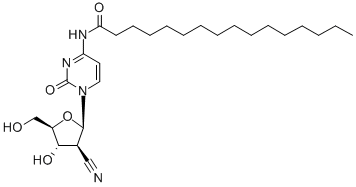Sapacitabine
CAS-Nr.
151823-14-2
Englisch Name:
Sapacitabine
Synonyma:
CNDAC;CS-682;CYC 682;CS-2513;Sapacitabine;10G, 50G, 100G, 1KG;Sapacitabine (CS682;Sapacitabine (CYC682);CYC 682; CYC-682; CS-682; CS682; CS 682;1-(2-Deoxy-2-cyano-β-D-arabinofuranosyl)cytosine
CBNumber:
CB91261450
Summenformel:
C26H42N4O5
Molgewicht:
490.64
MOL-Datei:
151823-14-2.mol
Sapacitabine Eigenschaften
Schmelzpunkt:
>177°C (dec.)
Dichte
1.21±0.1 g/cm3(Predicted)
storage temp.
-20°C Freezer, Under inert atmosphere
L?slichkeit
DMSO (Slightly), Methanol (Slightly, Heated)
pka
10.04±0.20(Predicted)
Aggregatzustand
Solid
Farbe
White to Off-White
Sicherheit
Risiko- und Sicherheitserkl?rung
Gefahreninformationscode (GHS)
Bildanzeige (GHS)
Alarmwort
Warnung
Gefahrenhinweise
Code
Gefahrenhinweise
Gefahrenklasse
Abteilung
Alarmwort
Symbol
P-Code
H302 Gesundheitssch?dlich bei Verschlucken.
Akute Toxizit?t oral
Kategorie 4
Warnung
P264, P270, P301+P312, P330, P501
H315 Verursacht Hautreizungen.
Hautreizung
Kategorie 2
Warnung
P264, P280, P302+P352, P321,P332+P313, P362
H319 Verursacht schwere Augenreizung.
Schwere Augenreizung
Kategorie 2
Warnung
P264, P280, P305+P351+P338,P337+P313P
H335 Kann die Atemwege reizen.
Spezifische Zielorgan-Toxizit?t (einmalige Exposition)
Kategorie 3 (Atemwegsreizung)
Warnung
Sicherheit
P261 Einatmen von Staub vermeiden.
P305+P351+P338 BEI KONTAKT MIT DEN AUGEN: Einige Minuten lang behutsam mit Wasser spülen. Eventuell vorhandene Kontaktlinsen nach M?glichkeit entfernen. Weiter spülen.
Sapacitabine Chemische Eigenschaften,Einsatz,Produktion Methoden
Verwenden
Sapacitabine, it is an orally available nucleoside analog prodrug of CNDAC that acts through a dual mechanism. It has potential use in chemotherapy.
Biochem/physiol Actions
Sapacitabine is an orally active prodrug of nucleoside analog CNDAC that exhibits potent anti-tumor activity in both blood and solid tumors. CNDAC incorporates into DNA where it causes single-strand breaks (SSBs), which are converted into double strand breaks (DSBs) during S phase.
Sapacitabine Upstream-Materialien And Downstream Produkte
Upstream-Materialien
Downstream Produkte
Sapacitabine Anbieter Lieferant Produzent Hersteller Vertrieb H?ndler.
Global( 55)Lieferanten
China 47
United States 8
Global 55
151823-14-2()Verwandte Suche:
N-[1-[(2R,3S,4S,5R)-3-cyano-4-hydroxy-5-(hydroxymethyl)oxolan-2-yl]-2- oxo-pyrimidin-4-yl]hexadecanamide
Sapacitabine
1-(2-C-Cyano-2-deoxy-β-D-arabino-pentofuranosyl)cytosine
1-(2-Deoxy-2-cyano-β-D-arabinofuranosyl)cytosine
4-Amino-1-[(3β-cyano-4α-hydroxy-5β-hydroxymethyltetrahydrofuran)-2β-yl]pyrimidin-2(1H)-one
CNDAC
1-(2-cyano-2-deoxy-β-D-arabinofuranosyl)-4-(palMitoylaMino)pyriMidin-2(1H)-one,Sapacitabine
2'-cyano-2'-deoxy-N4-palMitoyl-1-β-D-arabinofuranosyl-cytosine, sapacitabine, CYC682
CYC 682
Sapacitabine (CYC682)
10G, 50G, 100G, 1KG
CS-682
CS-2513
CYC 682; CYC-682; CS-682; CS682; CS 682
Hexadecanamide, N-[1-(2-cyano-2-deoxy-β-D-arabinofuranosyl)-1,2-dihydro-2-oxo-4-pyrimidinyl]-
Sapacitabine (CS682
151823-14-2
50-27-8
C26H42N4O5








